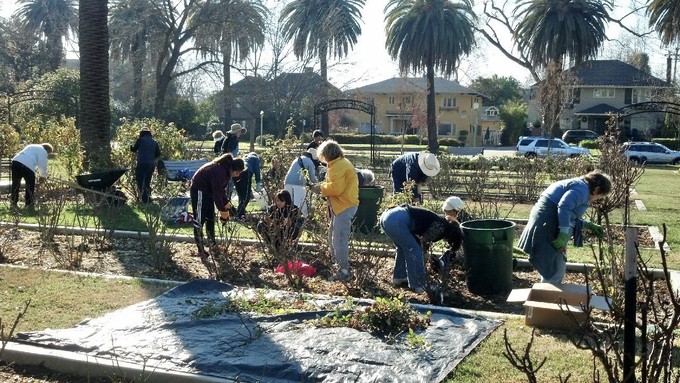
Be prepared for mud while learning about rose care

Volunteers in a previous January prune the McKinley Park roses. Two days of Prune-a-thons are scheduled this year, on Jan. 7 and 14. Debbie Arrington
It may be soggy, but we’ll be pruning. Despite heavy rains this past week, the Prune-a-thon at McKinley Park’s Memorial Rose Garden is expected to be held as scheduled on Saturday, Jan. 7.
Sacramento-area parks were closed mid-week due to concerns about falling trees and branches. (Or in the case of the rose garden, falling palm fronds.) But all parks are expected to be reopened by Saturday morning.
From 9 a.m. to noon, volunteers will be out in force to prune the beloved garden in McKinley Park.
Located on H Street near 33rd Street in East Sacramento, the rose garden is home to about 1,200 rose bushes, all in need of some TLC. All volunteers are welcome; no experience is necessary.
Skilled rosarians from the Sacramento Rose Society will lead volunteers, supervised by Sacramento parks employees.
Registration and parking are free. Water and light lunch will be provided. Volunteers under age 18 must have a parent’s or guardian’s signature to participate. Tools and instruction will be provided. Bring gloves and, if possible, bypass pruners.
Dress warmly. Considering how muddy the garden will be, wear closed-toe, water-repellent shoes or boots.
The Prune-a-thon is a great opportunity to learn about roses or reinvigorate pruning skills. It’s also a wonderful chance to show this historic rose garden some love.
In addition to tackling pruning (the biggest chore in any rose garden), the Prune-a-thon serves as a recruiting event for year-round rose garden volunteers.
Can’t make it Saturday? A second Prune-a-thon session is scheduled for 9 a.m. Jan. 14.
For details and to register in advance via QR code: https://bit.ly/3HQU9JM
Comments
0 comments have been posted.Sacramento Digs Gardening to your inbox.
Sites We Like
Garden Checklist for week of July 21
Your garden needs you!
* Keep your vegetable garden watered, mulched and weeded. Water before 8 a.m. to reduce the chance of fungal infection and to conserve moisture.
* Feed vegetable plants bone meal, rock phosphate or other fertilizers high in phosphate to stimulate more blooms and fruiting. (But wait until daily high temperatures drop out of the 100s.)
* Don’t let tomatoes wilt or dry out completely. Give tomatoes a deep watering two to three times a week.
* Harvest vegetables promptly to encourage plants to produce more. Squash especially tends to grow rapidly in hot weather. Keep an eye on zucchini.
* Pinch back chrysanthemums for bushy plants and more flowers in September.
* Remove spent flowers from roses, daylilies and other bloomers as they finish flowering.
* Pinch off blooms from basil so the plant will grow more leaves.
* Cut back lavender after flowering to promote a second bloom.
* It's not too late to add a splash of color. Plant petunias, snapdragons, zinnias and marigolds.
* From seed, plant corn, pumpkins, radishes, winter squash and sunflowers.